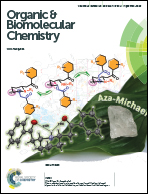Synthesis and biological evaluation of imidazo[1,5-a]pyridine-benzimidazole hybrids as inhibitors of both tubulin polymerization and PI3K/Akt pathway†
Abstract
A series of imidazo[1,5-a]pyridine-benzimidazole hybrids (5a–aa) were prepared and evaluated for their cytotoxic activity against a panel of sixty human tumor cell lines. Among them compounds 5d and 5l showed significant cytotoxic activity with GI50 values ranging from 1.06 to 14.9 μM and 0.43 to 7.73 μM, respectively. Flow cytometric analysis revealed that these compounds arrest the cell cycle at G2/M phase and induced cell death by apoptosis. The tubulin polymerization assay (IC50 of 5d is 3.25 μM and 5l is 1.71 μM) and immunofluorescence analysis showed that these compounds effectively inhibited the microtubule assembly in human breast cancer cells (MCF-7). Further, the apoptotic effects of compounds were confirmed by Hoechst staining, mitochondrial membrane potential, cytochrome c release, ROS generation, caspase 9 activation and DNA fragmentation analysis. After treatment with these compounds for 48 h, p-PTEN and p-AKT levels were markedly decreased. Moreover, these compounds did not significantly inhibit the normal human embryonic kidney cells, HEK-293. The molecular docking simulations predicted the binding interactions of 5d and 5l with colchicine binding site of the tubulin, which is in compliance with the antiproliferative activity data.
![Graphical abstract: Synthesis and biological evaluation of imidazo[1,5-a]pyridine-benzimidazole hybrids as inhibitors of both tubulin polymerization and PI3K/Akt pathway](/en/Image/Get?imageInfo.ImageType=GA&imageInfo.ImageIdentifier.ManuscriptID=C4OB01930J&imageInfo.ImageIdentifier.Year=2014)

 Please wait while we load your content...
Please wait while we load your content...